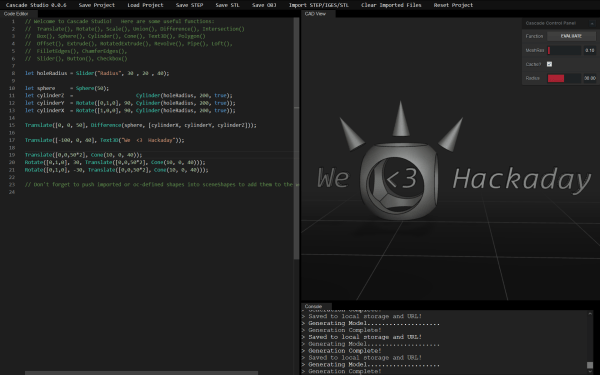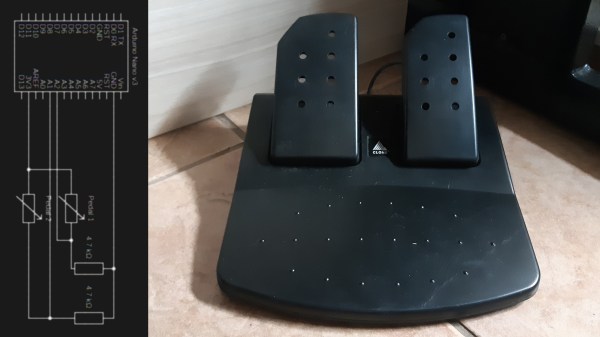Strong opinions exist on both sides about OpenSCAD. The lightweight program takes megabytes of space, not gigabytes, so many people have a copy, even if they’ve never written a shape. Some people adore the text-only modeling language, and some people abhor the minimal function list. [Johnathon ‘Zalo’ Selstad] appreciates the idea but wants to see something more robust, and he wants to see it in your browser. His project CascadeStudio has a GitHub repo and a live link so you can start tinkering in a new window straight away.
Author: Brian McEvoy267 Articles
Push Pedal For Privacy
Many of us in the secret Hackaday lair use gaming hardware at our work desks because it is reliable and performs well. We are not alone, and maybe you are reading this on your coffee break over a 20-button mouse. We wager that [Thiago Ribeiro de Azeredo] has this mindset because he converted some old analog gaming pedals into teleconferencing tools for his home office. Now that he is not racing to the office, he has to take a lot of computer calls, and he must quickly and covertly mute his microphone when his howling son tries to take the stage.
The pedals were gathering dust when he started working from home, but they are unretired for the upgrade. Inside, there is no mystery, just a couple of spring-loaded variable resistors, so he adds an Arduino Nano a couple of 4.7 kΩ resistors to create a voltage divider. The Nano doesn’t have native Human Interface Device (HID) functionality, so a Python script receives the serial port signals and toggles an application bar notification so he can see the microphone status. With two pedals, he can press-to-talk or lock his microphone on and off. We have to wonder, did he write the software during a meeting?
We love the idea of controlling our battle stations with our feet or seeing a bunch of RGB keyboards used as a low-res display.
Check Your Pockets For Components
The ideal component tester is like a tricorder for electronics — it can measure whatever it is that you need it to, all the time. Maybe you have a few devices like an ohmmeter and maybe a transistor socket on our multimeter. But what do you do when you need to see if that thyristor is faulty? [Akshay Baweja] wants an everything-tester at the ready, so he’s building a comprehensive device that fits in a pocket. It will identify the type and size of: Continue reading “Check Your Pockets For Components”
Road Pollution Doesn’t Just Come From Exhaust
Alumni from Innovation Design Engineering at Imperial College London and the Royal College of Art want to raise awareness of a road pollution source we rarely consider: tire wear. If you think about it, it is obvious. Our tires wear out, and that has to go somewhere, but what surprises us is how fast it happens. Single-use plastic is the most significant source of oceanic pollution, but tire microplastics are next on the naughty list. The team calls themselves The Tyre Collective, and they’re working on a device to collect tire particles at the source.
Continue reading “Road Pollution Doesn’t Just Come From Exhaust”
Textmeter Tells Its Tale
One time-proven method to make a lesson memorable is to make it a story, but that is not easy if your core material is the repair log of a rotted out analog ammeter. Most folks don’t need a 300A meter on their drill press, so [Build Comics] converted it to a text display and describes the procedure like they are writing a comic book. He is using HDLO-3416 LED cluster arrays for that dated-but-legible industrial feel, and everything looks right at home in a box made from oak and steel. Even the USB cord even gets a facelift by running it inside a fabric shoelace. In our own lives, covering charging cables is a hack on its own because we don’t want to fumble with the wrong charger when it is time to sleep or drive. Glow-in-the-dark cord upgrades, anyone?
We don’t have a pre-operation picture of the subject, but the innards suggest that it comes from the bottom of an industrial scrap pile. There is a cross-hatch pattern on the front plate, which hinted at 3D printing, but if you look closely at the early images, you can see that it is original. There is a nodeMCU board to fetch the date information and control the four alphanumeric displays. Except for the red lights, all the new hardware hides behind wood or steel, so this old workhorse’s aesthetic lives on and has a story to share that is a delight to read.
If you enjoy reading [Build Comics] and their adventurous recollections, we forecast you’ll enjoy this weather display, or maybe it is time to check out their clock, but we want to plant the seed of literary build logs.
In-vest-ing In Menopause
Most of us reach for an over-the-counter medicine if we have occasional pain, but menopause doesn’t act like that. Hot flashes don’t build like a headache, dizzy spells don’t wait for a good time, and panic attacks don’t announce themselves. Predicting and addressing sudden hormone shifts is the intent behind Menesto, a vest with sensors, cooling apparatus, and a companion app.
A thermometer and humidity detector monitor the skin for spikes in temperature and moisture to recognize when the wearer is having a hot flash. When an event is registered, a fan blows over a Peltier panel’s cool side and hopefully provides enough chilled air inside the vest. A Peltier panel is a thermoelectric heat engine that moves energy away from one ceramic plate to another, so one half gets cool while the other heats up. Power comes from rechargeable 18650 batteries and all the hardware talks to an ESP8266 on a NodeMCU running Arduino.
Mirror, Mirror, On Your Cam, Show Us What You’ve Drawn By Hand
Working and learning from home may be the new norm, and if IKEA shelves are any indication, folks are tricking out their home office with furniture, gadgets, and squishy chairs. While teleconferencing has proven to be an invaluable tool, paper documents aren’t going down with out a fight.
Unfortunately dedicated document cameras require significant space and monies, so they’re impractical if you only share once in a while. [John Umekubo] didn’t want students and teachers hobbled by the same costs and inconveniences, so he modeled a mirror holder that slides over a laptop’s webcam and directs the view downward.
[John]’s adventures started with a Twitter post, as seen below, but the responses were so encouraging that he published his design on Thingiverse for everyone. There’s also a version that can be laser cut out of cardboard, though we imagine a pair of scissors would work in a pinch. He admits there’s already a consumer model, but wasn’t planning to sell them anyway. Like us, he wants to get people to share their work.
We recently covered a simpler version of the same idea in use at Northwestern University, and we’ve seen a similar hack that gives a split-screen effect to sketch and maintain eye contact. If you want to share the view in your room, we have a Raspberry Pi streaming option that’s worth checking out.
Continue reading “Mirror, Mirror, On Your Cam, Show Us What You’ve Drawn By Hand”





















